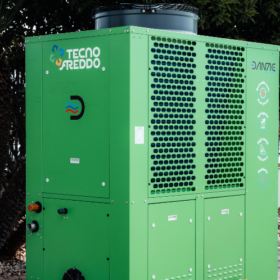U.S. researchers developing photovoltaic dual-axis canopy
The “morphing skin” would track sunlight and have the flexibility and surface area to wrap across large surfaces, such as buildings and stadiums.
TrinaStorage launches Elementa 3 utility-scale battery storage system
The new utility-scale battery energy storage features 565 Ah cells and delivers a rated capacity of 6.017 MWh with a typical discharge duration of four hours.
EcoFlow launches balcony PV system, batteries with AI features
EcoFlow’s new Stream series, its second-gen balcony solar plant, enables battery coordination and plug-and-play solar for distributed batteries, plus third-party microinverter coordination for its new battery.
Frascold, Tecnofreddo present high-temperature propane heat pump
Conceived for industrial applications, the Danae heat pump system is available in 10 versions with cooling capacities ranging from 22.1 kW to 156.9 kW and heating capacities spanning from 24.8 kW and 181.6 kW.
Japan’s NEDO opens fiscal 2025 funding round for solar tech innovation
Japan’s national energy R&D agency has launched a five-year R&D program to accelerate solar innovation. The fiscal 2025 call for proposals seeks advances in high-efficiency cells, site-specific systems, PV module recycling, and long-term power stability.
Australian entities say V2G tech ready for market
Essential Energy, the Commonwealth Scientific and Industrial Research Organisation (CSIRO), renewable tech company Sigenergy and electric vehicle distributor AUSEV have jointly announced vehicle-to-grid (V2G) technology is market ready in Australia.
Acoustics for solar harmony
Fixing a project’s acoustics can be costly and difficult, but easily avoided if considered early in the project’s development.
New research sheds light on intrinsic limitations of selenium solar cells
Danish researchers have analyzed fundamental material properties of selenium solar cells and have found their potential is higher than generally believed. They used carrier-resolved photo-Hall analysis to address discrepancies and reproduce experimental current-voltage and external quantum efficiency measurements.
Sungrow launches fully integrated C&I battery
With a fully integrated power conversion system (PCS), battery management system (BMS), and energy management system (EMS), PowerStack 255CS aims to streamline energy storage operations while reducing installation complexity.
Poland’s micro-solar growth slows slightly in 2024
Poland’s micro-scale solar sector grew to 1.5 million systems and 12.7 GW in 2024, with slower growth in both new installations and energy exports, according to the country’s energy regulator.










